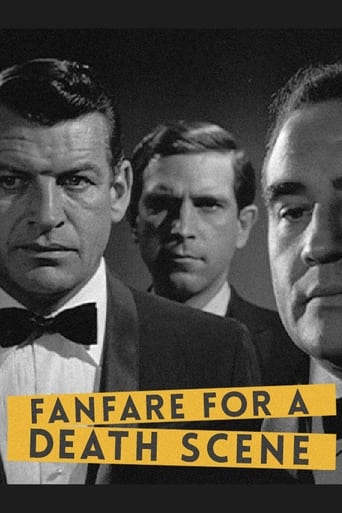gridoon2018
"Fanfare For A Death Scene" has an intriguing opening (the camera slowly explores a sanitarium that turns out to be full of dead bodies, while a crazy atomic scientist with an obsession for trumpet music has just escaped), but what follows is very low budget, technically rough (even taking into account that I watched a poor print), and mostly dull. The director must have had a fetish for the sight of planes taking off and landing, because about 10 out of the film's 70 minutes are taken up by footage of exactly that. Richard Egan is OK if not inspiring as the lead, Tina Louise is underused, and Telly Savalas plays the Mongolian (!!) arch-villain who never gets captured or killed; apparently this film was designed as the pilot for a TV series that wasn't commissioned, which explains why the ending, although finally featuring some action, feels so rushed and incomplete. *1/2 out of 4.
tavm
Just watched this action thriller on Netflix streaming. It stars Richard Egan as John Stryker, a businessman who's supposedly retired from the U.S. spy business but reluctantly takes a call after being told that a crazed scientist played by Burgess Meredith has disappeared from an institution after 9 staff members were found dead. Khigh Dhiegh, who years later became the original Wo-Fat on the original "Hawaii Five-O" is one of the villainous henchmen on the run looking for him but the real mastermind is played by Telly Savalas in a stereotypical Asian role that would be politically incorrect today though he does seem to relish his attempt to speak like an Occidental Fu Manchu-type character which makes it a little fun to watch. Also interesting were Viveca Lindfors and Tina Louise as Savalas' female assistants and an appearance of jazz legend Al Hirt for a concert appearance and a connection with Meredith's character. I also liked Ed Asner and J.D. Cannon as Striker's associates. If there was some quibble from me, I'd say there was not enough action for this 73-minute movie as some long dialogue scenes could have used some tight editing though the continuously playing score does keep things from getting too boring and while the ending seemed abrupt, it was exciting enough. So on that note, Fanfare for a Death Scene is worth a look if you're curious enough.
secondtake
Fanfare for a Death Scene (1964)With a shaky camera start in a bizarre scene in a sanitarium, with people frozen in macabre deaths, we know we are in for something both completely weird and something very low budget. There is a whole slew of well known actors in the cast, including Burgess Meredith (doing an improbable opening crazy scene with a trumpet.The year (1964) is the height of Cold War movies in the U.S., and this one is actually that, too. The lead character is Mr. Stryker, a businessman played by early television standard Richard Egan. His character is so self-important he can't answer the phone for the Joint Chief of Staff. So it turns out Stryker is also a detective in his spare time, and he has to track down the Meredith character, who is a top physicist.An amazing cameo by Al Hirt almost justifies everything--the famous trumpeter blows some of the flashiest and smartest ad lib wailing you'll hear on a 1960s horn player. I know. I play trumpet, and there is subtlety and extroverted intensity together in this. One other person worth noting is Viveca Lindfors, who had a strange and varied career, but who was enormously talented at a time when the movie industry was dying, and she ended up going less far than you'd expect. And finally look for Ed Asner in a small appearance.There is even more going on with the camera--odd angles, extreme wide angle, the shaky camera stuff, shifts from normal shooting to surveillance cams, fast moving dollies, on and on. There is a terrific fight scene in a room lit with irregular horizontal lines of light. It's a virtuosic approach that might be thought to be distracting but in fact is part of the craziness that makes this thing work. Or partly work. It's so stylizing and affected it gets almost silly, but then it's also hard edged and original, like a later "Detour" or some other B-movie drama that's become a classic."What is it?" a woman asks.Stryker says, "It's either the mouthpiece for a trumpet...or the end of the world."
telegonus
I can't remember too much of the plot of this movie except to say that it is, at least on the surface, a slick thriller, but stylistically it's so original and bizarre at times as to be riveting just for its visual flair, the compositions, the very sixties mood, which suggests that everyone is or could be unbalanced. Richard Egan makes a less than exciting hero but is in some ways good casting, as a more eccentric or individualistic actor might have tipped the movie into the realm of the totally bizarre, from which it might not have been able to escape. The eclectic cast includes Tina Louise, Ed Asner and Telly Savalas. Burgess Meredith is excellent as a very important character in the film, and while he's not on screen much he does get to play the trumpet and overall nicely suggests a man who has quite plainly and simply lost his marbles. Most of the credit for this offbeat and entertaining picture belongs to its director, Leslie Stevens, a gifted and sadly too often overlooked and underrated film-maker. He was probably slumming a bit when he made this one, but he gave it his best shot, which is very good indeed. The film is listed as having been made for television, though I wonder if it was first shown on the small screen due to its offbeat qualities, which might have made it difficult to sell in theaters. It's definitely worth watching if one likes movies made in an original and unconventional style.


 AD
AD



